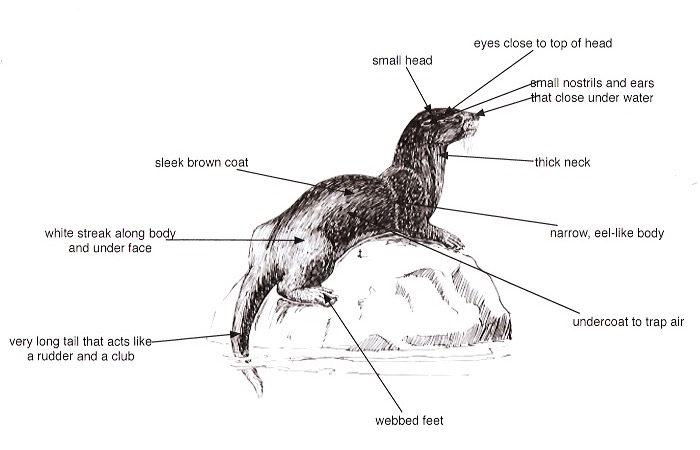Land Otters
Introduction
European Otter Map The land otter is part of the MustelidMustelid family. Its cousins includeinclude badgers,badgers, ferrets,ferrets, mink, skunks and weasels.weasels. But did you know that beaversbeavers belong to a different family? Land otters are found in unpollutedunpolluted fresh water lakes, streams and rivers in Asia,Asia, Africa,Africa, EuropeEurope and in North America. Otters are fun, playfulplayful animals that are highlyhighly intelligentintelligent and that make and use tools.
The land otter is part of the MustelidMustelid family. Its cousins includeinclude badgers,badgers, ferrets,ferrets, mink, skunks and weasels.weasels. But did you know that beaversbeavers belong to a different family? Land otters are found in unpollutedunpolluted fresh water lakes, streams and rivers in Asia,Asia, Africa,Africa, EuropeEurope and in North America. Otters are fun, playfulplayful animals that are highlyhighly intelligentintelligent and that make and use tools.
What Do Land Otters Look Like?
Parts of an Otter's Body An otter is over one metre in length with nearlynearly half of that made up by its tail. Its sleek, dark brown coat has a white streak alongalong its body and under its face, down to its belly. Each land otter has its own individualindividual markings.markings. Their small heads are joined to their narrownarrow eel-like bodybodies with a thick neck. On their heads their eyes are close to the top and they have small nostrils and ears that close when they go under the water. WebbedWebbed toes on their short legs help them on land and in the water, along with their tails, which act like a rudderrudder and which they use to protectprotect themselves.themselves. Otters do not have any blubber.blubber. Instead they have an undercoatundercoat where the air is trapped.trapped. This keeps the otters warm in the water.
An otter is over one metre in length with nearlynearly half of that made up by its tail. Its sleek, dark brown coat has a white streak alongalong its body and under its face, down to its belly. Each land otter has its own individualindividual markings.markings. Their small heads are joined to their narrownarrow eel-like bodybodies with a thick neck. On their heads their eyes are close to the top and they have small nostrils and ears that close when they go under the water. WebbedWebbed toes on their short legs help them on land and in the water, along with their tails, which act like a rudderrudder and which they use to protectprotect themselves.themselves. Otters do not have any blubber.blubber. Instead they have an undercoatundercoat where the air is trapped.trapped. This keeps the otters warm in the water.
How Do Land Otters Move?
| Fact Box |
|
Otters do very well in zoos where they are a favourite with the visitors.
|
Otters make their homes out of grass and leafleaves at the foot of trees or in holes in the riverbank.riverbank. Their homes are called holts or couches. When they swim, otters dive, twist, turn and performperform somersaults,somersaults, even when they are old. SlideSliding down muddymuddy banks and snow is one of their favourite things to do. Otters dive to find food, stayingstaying underwaterunderwater for up to four minutes.
What Do Land Otters Eat?
Otters hunt at night and they make undergroundunderground tunnelstunnels to move from the land to the water. The main thing that they eat is fish, but they also eat birds, frogs, crustaceans,crustaceans, baby beaversbeavers and rabbits.rabbits. They probableprobably eat berryberries and plants.
What is the Land Otter Life Cycle?
Land otters do not have a particularparticular matemating season,season, which means that the babies can be born any time. Mating happenshappens in the water and 61 days later, one to four babies (whelps) are born. For the first year the whelps drink milk from their mothers. They stay in their dens and do notdon’t go into the water until they have got their waterproofwaterproof coats, that is, after two months. Otters can live up to 16 years in the wild.
 Otters love clean water - no rubbish or pollution!What are Dangers for Land Otters?
Otters love clean water - no rubbish or pollution!What are Dangers for Land Otters?
Otters have a Near ThreatenedThreatened status,status, which means that they are not endangeredendangered but they still need to be looked after so they do not reach Endangered status. They are extinct in SwitzerlandSwitzerland and the Netherlands,Netherlands, countrycountries in Europe. The were huntedhunted for their pelts but it is illegalillegal to hunt them now. PesticidesPesticides and pollutionpollution are a big problemproblem for otters because they like clean water.
Conclusion
Otters have crazy personality!personalities They are the gymnastsgymnasts of the riversrivers and ponds. They are designeddesigned to be wonderfulwonderful swimmersswimmers with their bodies like eels, webbed toes and their long tails. SupplementingSupplementing their diet with plants makes them omnivoresomnivores like us. We must care for these beautiful animals so that they don’t become extinct.
Glossary
| blubber | a layer of fat to keep an animal warm | pesticides | chemicals sprayed on plants to kill insect pests |
| couch | an otter's den | rudder | something to steer a boat |
| crustaceans | sea animals such as lobster, shrimp and prawns | supplementary | adding to |
| holt | an otter's den | unpolluted | not made dirty and poisonous from rubbish and chemicals |
| Mustelid | family of small mammals such as ferrets, stoats and skunk | whelps | baby otters |
Bibliography
Mrs Nunweek's Fact File
By Molly
Photograph by Derrick Coetzee
{chronoconnectivity5}L2L_NF2_Feedback{/chronoconnectivity5}